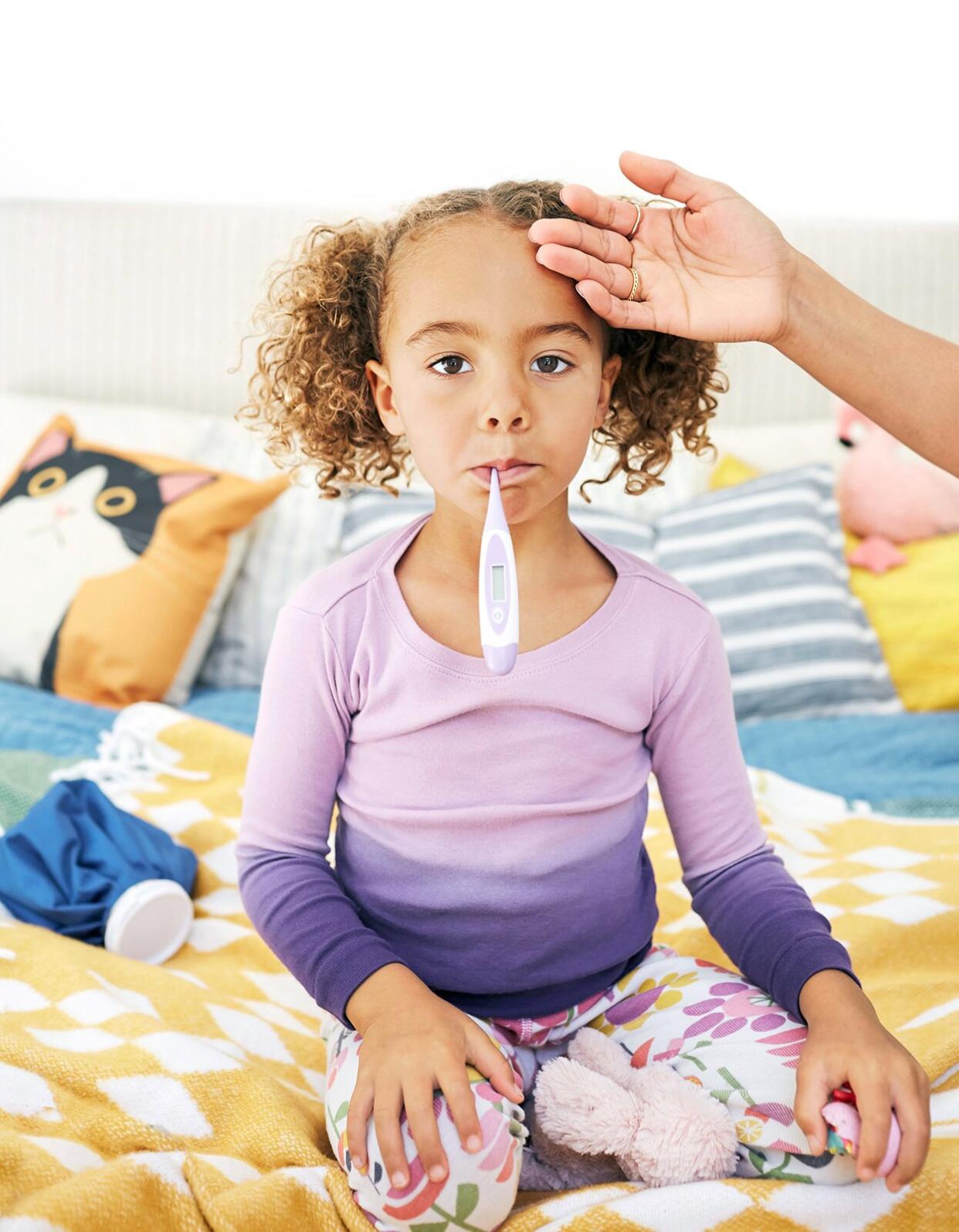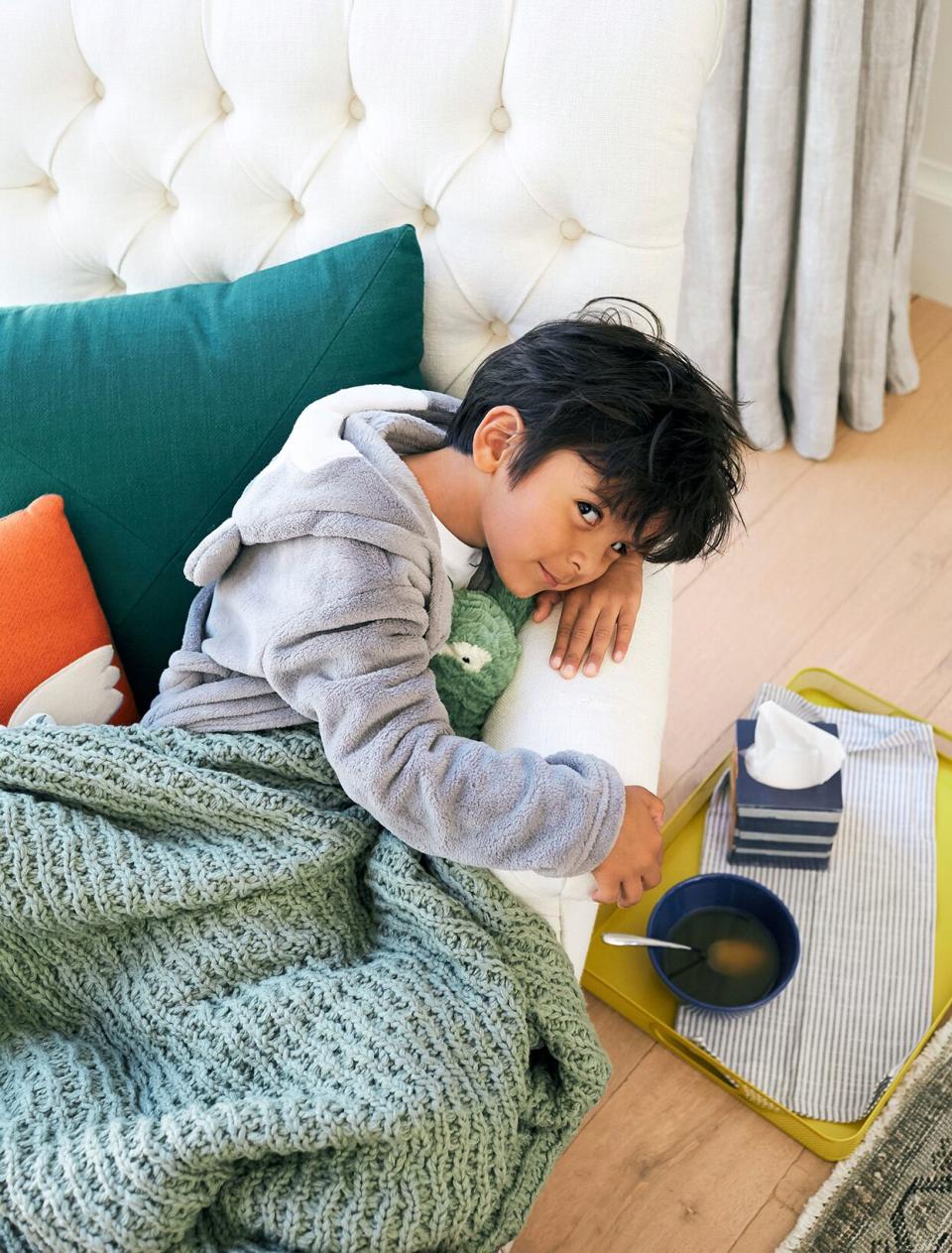I'm a Dad and a Pediatrician: Here's When I Worry About a Cold

Priscilla Gragg Yep. It's got to go all the way under her tongue.
Before I had kids, I admit I was a little judgy of parents who took sick children out in public. I’d see a toddler with two snot streams running down his face, snicker at his resemblance to a walrus, and swear that I would never let my future offspring walk around like that. I’m sure you can guess how that turned out: I’ve had enough walrus moments with my own kids to fill a nature documentary.
The average child will catch six to eight colds every year during the first few years of life. Here’s the tricky part, though: What seems like a cold can sometimes be something worse. Most fevers, coughs, and runny noses are harmless, but occasionally they can be signs of more serious conditions like bronchiolitis, sinusitis, middle-ear infections, influenza, or even pneumonia. However, no one wants to waste time and money on unnecessary medical visits, expose their child to a germy waiting room, or dose her with antibiotics that won’t alleviate her symptoms. To avoid these scenarios, let’s look at one symptom at a time.
Fever
A high temperature may be the symptom that worries parents most. Whether it also concerns doctors depends on the child’s age, how long the fever has lasted, and in some cases how high it is. Typically, you’ll notice that a child who’s already suffering from a cold looks either pale or flushed and is warm to the touch.
The first step with fever is to confirm that there actually is one. The human hand makes a poor thermometer, so you should always take an actual temperature if you’re concerned. The way you check also matters. A rectal thermometer for young children and an oral thermometer for older children (who can reliably hold one under their tongue) remain the gold standards for accuracy. But an ear thermometer can be useful for children older than 6 months, and temporal artery (forehead) thermometers are growing in popularity. Both indicate a temperature higher than 100 as a fever, as does an oral thermometer; for a rectal thermometer, it’s 100.4 or higher. An armpit (axillary) temperature of 99 or more may suggest that your child has a fever, but ideally you’d double-check with a more accurate method.
RELATED: How to Treat Baby's First Fever
For infants under 12 weeks, doctors consider fever a medical emergency since it can be a sign of a serious infection. Newborns up to 28 days old are almost always hospitalized for two days if they have a fever. Babies between 1 month and 3 months should also be examined right away when they have a fever, although, unlike newborns, they may not always be hospitalized.
If your child is older than 3 months, the significance of fever depends on whether there are other symptoms present and how long they last. Colds often cause fever (an effect of the immune system cranking up to fight the infection), usually for about two days; a fever that lasts longer may suggest a bacterial sinus infection, a middle-ear infection, or pneumonia. Fever may result from a urinary-tract infection in children under age 2 who are without any other symptoms, warranting at least a call to the doctor and usually a visit. After her second birthday, if your child doesn’t seem unusually ill, you can most likely wait for the third day of fever before calling in your concerns.
The number on the thermometer can’t tell you whether your child has a viral or a bacterial infection or how serious it is. Many parents worry that a high fever will cause brain damage, but this is not a concern for a temperature under 107. Healthy children don’t generally get temperatures this high from illness but instead from external issues, like being locked in a hot car.
Runny Nose
Back when I was a medical student (and Destiny’s Child was still touring), the party line on nasal mucus was simple: If it’s green, the infection is bacterial, not viral, and the child needs antibiotics. Then we figured out that snot almost always turns green during a cold, and only around 7 percent of the kids who’ve got the green stuff benefit from antibiotics. Now we pay attention to two things: the snot’s duration and its severity.
Duration is easy: Most colds get better in about a week, so a child whose nose has been running for more than ten days might benefit from antibiotics—he’s likely suffering from acute bacterial sinusitis—as will a child with symptoms that seem to get better after several days but then worsen again. For children of all ages, severe symptoms are defined as at least three days of yellow or green snot and a fever over 102.2. Sinus infections do happen in young children, even though they are born with only two of the four pairs of sinuses (maxillary and ethmoids) adults have. (The other two pairs develop later in childhood.)
Other factors can also make noses run. Environmental allergies bring clear, watery snot, sneezing, and itching. Mucus draining from only one nostril suggests that a foreign body is stuck in a child’s nose. And on the more extreme end, clear nasal drainage following a severe head injury can indicate a dangerous skull fracture.

Priscilla Gragg
Earaches
Middle-ear infections (aka acute otitis media) lead to more antibiotic prescriptions than any other childhood illness. But not all earaches are from these ear infections. A tiny passage called the eustachian tube runs from each middle ear to the nose, and viral illnesses and allergies can clog these tubes with mucus, causing pain. Colds can also cause fluid to collect in the middle ear (serous otitis media), which can be uncomfortable but is not a bacterial infection (and therefore does not require antibiotics). Swimmer’s ear (otitis externa), in which excess moisture collects in the outer ear, can be terribly painful but is treated very differently from otitis media.
In fact, there are several causes of earache that have nothing to do with colds or ear infections—everything from changes in altitude to swollen adenoid glands. Children who are without fever, who are older than age 2, or who have an ear infection on just one side may not need any treatment beyond pain relief. But that’s best determined by an in-person exam, so if your child has severe or worsening ear pain, drainage from the ear, or an earache with fever, see the doctor.
Cough
This may be the most annoying symptom of a cold, since it often keeps both kids and parents awake and can linger for up to three weeks. Cold viruses cause coughing by inflaming airways and producing nasal drainage, which drips into the lungs and then must be forced back out. Normal coughs can sound dry, wet, or barking, but other cough-related symptoms should prompt you to seek care.
Newborns and infants, especially if born prematurely, can contract bronchiolitis, a viral infection often ushered in by respiratory syncytial virus (RSV), which can lead to life-threatening wheezing. To diagnose bronchiolitis in babies (it usually doesn’t occur after the first year), doctors look for four signs of respiratory distress: a grunting sound with each breath, flaring of the nostrils, skin pulling under or between the ribs, and breathing too fast (more than 60 times per minute). If you hear a high-pitched wheeze or notice any of these signs, call your doctor.
Another concerning sign is in some ways the opposite of a wheeze: stridor. Wheezing occurs when someone is breathing out, while stridor is a high-pitched noise that children make as they are breathing in. A child with croup may have stridor when he is crying or upset, but if you hear stridor occurring when your child is resting, head for a doctor’s office, an urgent-care center, or the emergency department right away. If she also seems very short of breath, call 911 instead.
Wheezing with a cough is a hallmark of asthma. If your child has already been diagnosed with asthma and you find yourself giving her rescue medicine more often than every four hours or for more than one day in a row, it’s time to call her doctor. Also call if your child seems short of breath during normal activities like walking or running, or can’t say long sentences without catching her breath.
RELATED: How to Manage Your Child's Asthma
A cough can also indicate pneumonia. Children with pneumonia may have a fever beyond the first two days of an illness, and may also complain of chest pain or shortness of breath. Pneumonia can be quite dangerous, so seek care soon if you’re seeing this combination of symptoms.
Other Troubles
Headaches are common with colds, especially when your child also has a fever, but they shouldn’t be severe or bring about vomiting, light sensitivity, or a stiff neck. Those can be signs of meningitis, a serious infection of the fluid around the brain, and your child should be checked out immediately if he exhibits any of these symptoms.
Sore throats are certainly common with colds as well, especially scratchy ones that hurt worse with coughing. In kids older than age 3, we also worry about strep throat (it’s not impossible for strep to afflict a child younger than 3, just less likely). Strep usually comes with a fever and rarely with a cough, so many doctors will check a child’s symptoms and look for throat redness and swollen neck lymph nodes before even ordering a test for strep bacteria. Be aware that strep should never be treated with antibiotics without a doctor first performing a rapid strep test, a throat culture, or both.
Colds may come with some muscle aches but generally don’t cause tummy aches, vomiting, or diarrhea—all of which suggest influenza, especially at this time of year. Whether your child needs a flu test depends on his age, how long he’s been sick, and whether he has other conditions like asthma or heart disease; his doctor’s office can tell you whether a visit is in order, so call if you see any of these symptoms.
This article originally appeared in Parents Magazine's November 2019 issue as 'Hey Doc, Is It More Than Just a Cold?'

